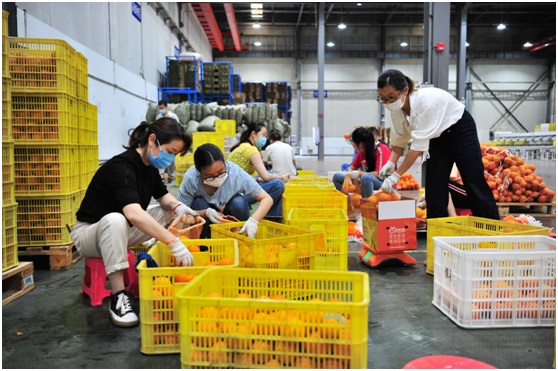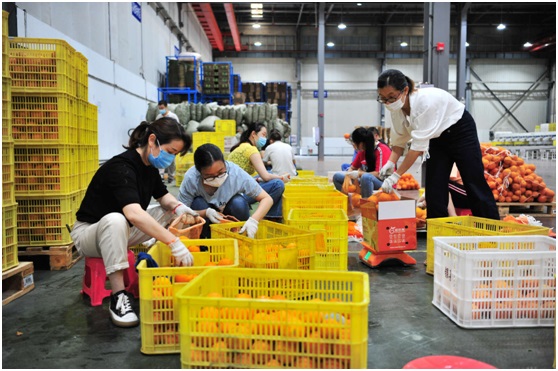



By Luo Shanshan, People’s Daily
China’s online retail is now quickly making up the losses suffered by the offline sector during the COVID-19 epidemic.
According to China’s National Bureau of Statistics, the online retail sales of physical goods went up by 11.5 percent in the first five months this year, accounting for 24.3 percent of the total retail sales of consumer goods. China also saw its express delivery volume surge 41 percent year-on-year in May, and the revenue of express delivery companies increased 25 percent year-on-year, said the country’s State Post Bureau.
With emerging new businesses and vital online consumption, the online retail sales of physical goods is contributing an increasingly larger share to the growth of the consumption market, bringing more benefits and convenience to the consumers.
At 4:00 a.m. every day in Yantai, East China’s Shandong Province, the machines at a logistics distribution center of Suning Logistics, a Chinese self-operated retail logistics company, crank up. Parcels are being sorted by employees and then loaded onto vehicles heading for 12 first-level branches, where the commodities will be sorted again and shipped to over 200 service centers in different townships.
“There is a huge demand for online service. Our delivery volume expanded by about 23 percent on a yearly basis in May,” introduced Wang Baoyu, a principal of a Suning Logistics service center in the city.
The growth in online retail sales of physical goods indicates strong momentum of China’s consumption upgrading.
“Although we had to stay at home, we could still taste the delicacies in different parts of the country,” said Zhang Ju in Hefei, capital of East China’s Anhui Province. She placed an order online of Orah mandarins, a specialty of Wuming county of Nanning, South China’s Guangxi Zhuang Autonomous Region, after her relative-visiting trip to Guangxi was suspended by COVID-19. “The mandarins were delivered to me on the second day,” Zhang said, adding that the fruits were tasty and fairly priced.
As consumption upgrading accelerates, consumers’ demands are becoming increasingly diversified and personalized. The consumption upgrading showed a strong momentum in the January-May period despite the impacts of the COVID-19 epidemic, and commodities from across the world are now accessible on e-commerce platforms for the Chinese public.
The growth in online retail sales of physical goods indicates flourishing new consumption.
A livestreaming marketing event was recently held by Pinduoduo, an interactive e-commerce platform in China. It attracted a total of 7.23 million consumers in 48 hours, gaining over 630,000 new followers for enterprises on the platform.
The event was joined by multiple government officials, including He Jinshan, head of Nankang district, Ganzhou of East China’s Jiangxi Province, who tried to sell furniture made of the solid-wood produced in the district. When the event concluded, Nankang’s furniture manufacturers achieved a turnover of over 50 million yuan ($7.08 million).
China’s e-commerce live-streaming sessions topped 4 million in the first quarter, in which over 100 mayors and county chiefs promoted local products, according to statistics released by the country’s Ministry of Commerce.
New online businesses accelerated their innovation in the epidemic, and new consumption, such as influencer marketing and community-based group buying, also demonstrated strong vitality.
Driven by digital technology, new online consumption is able to better match the demand and supply sides, tap into the potential of regional industrial clusters, and facilitate the resumption of production of relevant enterprises. It also helps make up the declined consumption, unleash the consumption potential, boost economy and stabilize employment.
The growth in online retail sales of physical goods indicates the vast space of China’s domestic market.
Chinese e-commerce giant JD.com kicked off its annual shopping festival on June 1 and witnessed robust sales thanks to its high-quality service.
Statistics showed that the total transactions on the company’s platform reached a staggering amount of 269.2 billion yuan from June 1 to 18, and 187 brands gained more than 100 million yuan on the platform during the same period. The orders of home appliances,groceries and daily necessities all increased.
China is a country with 1.4 billion people, including 400 million middle-income earners. As one of the world’s largest markets, the country is bringing its consumption upgrading into full swing.
At present, various policies to stimulate consumption are taking effect, and online and offline consumption is becoming more energetic, injecting more impetus to the high-quality development of China’s economy
  |
| Workers pack oranges for online orders in an e-commerce industrial park in Yiling district, Yichang, Central China’s Hubei Province, June 18. (Photo by Zhang Guorong/People’s Daily Online) |


The Executive and members of the.


The Acting Director, FCT Directorate of.


President Bola Ahmed Tinubu has been.



Barely a month after resignation of.


An Abuja based Legal Practitioner, Osuagwu.



Convener of Equitable Remedy, Mrs. Magaret.


Contractors handling the contract for city.


Nigerian government may have concluded plans.


The Diplomatic Correspondents Association of Nigeria.


A rights group, “Follow Me Talk.
Leave a Comment